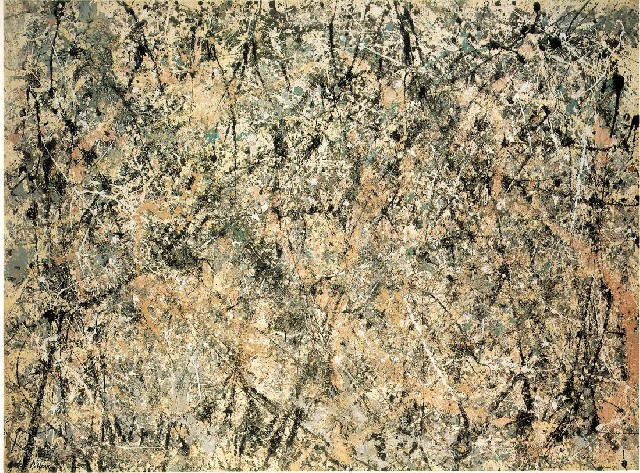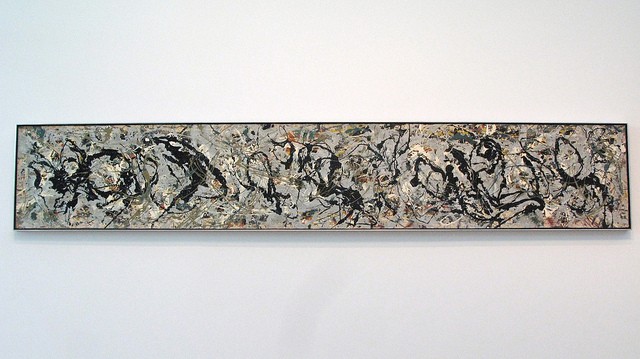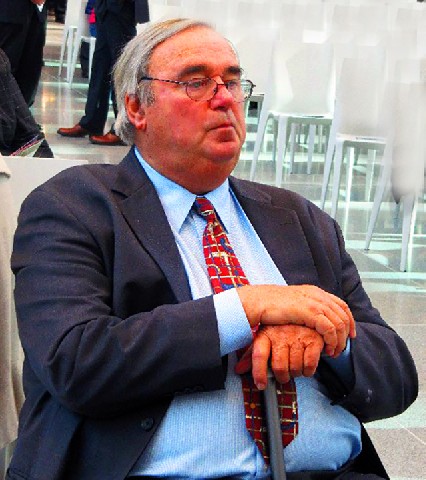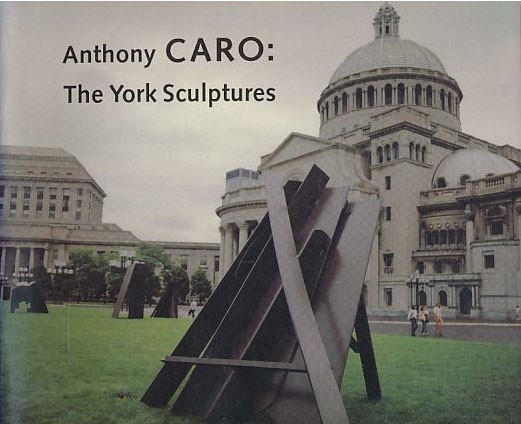Ken Moffett Part Two
Missing Out on Lavender Mist and a Mondrian
By: Charles Giuliano - Mar 11, 2015
Charles Giuliano You convinced the Long Island artist/ collector Alfonso Ossorio to sell the Jackson Pollock masterpiece"Lavender Mist" to the MFA. Apparently then director Merrill Rueppel blocked the sale. Can you tell us what happened?
Kenworth Moffett I wasn't in the room I just heard it second hand. I made the presentation and then the curator has to leave for the trustees to deliberate.
CG As I have previously reported the trustees met and said 'Let's get the new guy (Rueppel) in on this.' He had questions about potential conservation of the fragile dripped surface. Bill Young of the conservation lab was called in. He stated that he had no experience with conserving a painting of that nature. Consequently the acquisition was rejected. Is that a fair description of the decision?
KM To get an accurate account you would have to talk to somebody who was in the room. But I know that Rueppel was not for it. He didn't get behind it. No.
CG In your essay you comment that like Rathbone he was holding back his chips to spend on his own acquisitions.
KM Exactly. He wasn't the right choice. (for director) It was brief. He left pretty quickly. It wasn't a good period. No.
CG In terms of what you acquired for the MFA how much of a difference would "Lavender Mist" have made as its keystone?
KM It's the greatest picture Pollock ever made. It would have been on view all of the time as it is at the National Gallery. It would have been one of the greatest paintings they have.
CG Great works also attract further gifts and acquisitions. How damaging was it not to get that masterpiece?
KM It definitely would have helped. They have a wonderful picture a wonderful Pollock. ("Number 10." 1949) It's up there with "Number 1" at MoMA and "Autumn Rhythm" at the Met. "Lavender Mist" is one of the key pictures, right?
CG They later acquired "Troubled Queen." (1945)
KM That was a good acquisition.
CG It was controversial at the time. It was acquired through the Juliana Cheney Edwards fund by exchange. The deal entailed deaccessioning Renoir's "Girl with a Red Bonnet" another Renoir and a Monet landscape. They were swapping 19th century French impressionism for Post War American painting. The image of the Renoir was at the time the best selling post card in the museum's gift and book shop. It is normal to swap apples for apples but this was apples for oranges.
KM They have so many 19th century French paintings and this was a major picture. For the time it's an outstanding picture. Pollock painted so many great ones.
CG It's not "Shewolf" or "Male Female."
KM It's a wonderful picture. Time and again the Pollock jumps out at you. You look around the room and boom there's Pollock.
CG During meetings of the powerful MFA curators you describe being the low man. Compared to your peers you were part time with just a secretary. The newly formed department had no endowment or funding.
KM I got good support from Perry (T. Rathbone). They didn't have a curator of painting so there wasn't that much momentum to buy stuff. So I was able to get some important pieces during that period. Once (John) Walsh came in and (Theodore E.) Stebbins came in it was different and made it much more difficult.
CG I don't quite get what you mean about Walsh and Stebbins.
KM Both of these guys are coming in as curators and want to make a mark. They want to spend some of the money and they had their priorities. So right away I had a lot more competition. Then they came from powerful departments (European and American) with lots of people working there. They had stronger positions so I wasn't able to do as much as I had before. That was the most important single difference.
CG In the piece you posted for us you describe a failed attempt to acquire a painting by Mondrian. That was the first I knew of that.
KM It was a wonderful picture as I recall from 1929. It was from the perfect period. That's when he widened the horizontal lines. Changing the width of the lines helped the pictures enormously. You could see that in the big Mondrian show at the Guggenheim. I got help from Bump Hadley at the Gardner Museum. As I said, I couldn't get support because they had their priorities. The Mondrian could have been so important in telling the story of abstraction. I did what I could.
CG What was the time line of your mandate? Were you looking at modernism or confined to Post War American?
KM That's it.
CG So you were not pursuing Picasso, Matisse or School of Paris.
KM No, although I was very mindful as I said in the piece that we didn't have the proper works to tell the modernist story. We had impressionism and post impressionism. But when it gets to Matisse, Picasso and Cubism we didn't have the works and I always thought in those terms. So I did propose some things. I got the Miro and the Picasso which is a wonderful picture. It's a Cubist picture from 1910.
CG "Portrait of a Woman?"
KM Yeah. Fabulous. I did those though I struck out on the Mondrian.
CG It is often said that the taste of Boston is Germanic and not French from the BSO to the MFA, early ICA and Harvard. Early on the ICA championed Kokoschka and Egon Schiele. Of course there is the great Busch Reisinger Museum at Harvard. Perry arrived having been a friend of Max Beckmann in St. Louis. He showed Beckmann as well as (Ernst Ludwig) Kirchner. He acquired expressionism and a key work by Edvard Munch.
KM Then there was Hyman Bloom and that whole thing. (Boston Expressionism) Absolutely you're right about that. That was not my focus. Although I knew German art pretty well. I lived in Germany. But that was not my focus. I was into the modernists.
CG Did you sense the Germanic tradition when you were at the Fogg?
KM No. At that point. Later it went into theory with T. J. Clark and all that stuff. Words about words. At that time it was different. The focus changed. When they got T.J. Clark he was going in the opposite direction. At that time, as you point out, it was coming out of Arthur Pope and Paul Sachs. That why they went out and got Jakob Rosenberg and Sydney Freedberg, Seymour Slive and all of that.
CG Other than Lewis Cabot were there other significant collectors supporting your program?
KM I got some support from Steve Paine. And I got some support from Graham (Gund). I was counting on Graham's pictures especially for Noland. I didn't focus much on Noland because he had such great Nolands. You have to think like that when you have limited things you can do. I talked to Graham and asked can I count on that? So they knew what pictures I definitely hoped they would give to the museum.
CG Has Graham given anything to the museum?
KM I don't know. I left Boston, I have contacts there. Tom Wong (exhibition designer) and Clementine (Brown former director of PR). Lewis kind of drifted off the board. I think he left the board for awhile so he wasn't up to date with what was going on.
CG How do we explain that the MFA was able to acquire such a great collection of impressionism and post impressionism. By the 1920s it seemed that they followed the pronouncements of the Asiatic curator Ananda Kentish Coomaraswamy (22 August 1877 − 9 September 1947) that the only good artists were dead artists.
(When Georgia O'Keeffe gave him a portfolio of photographs of her by Alfred Stieglitz he stuck them in a drawer in the basement where they were lost for decades.)
You wrote about how Walter Muir Whitehill opposed your appointment and an MFA interest in contemporary art. How did Boston become so conservative? As a result the MFA missed the boat on the art of the 20th century.
KM Especially the French and modernist developments. Why did that happen? The Armory Show bombed in Boston, right?
CG It was shown at the Copley Society.
KM It was the only place where it didn't receive raves or at least controversial brouhaha.
(The 1913 Armory Show was exhibited in New York, Chicago and Boston. Because of the lack of space in Boston all of the American art was removed.)
In Boston the show was a dud. So it seems they weren't ready.
CG When Frank Lloyd Wright lectured in Boston he said "What Boston needs is 100 first class funerals."
KM Why that happened I really don't know.
CG When you left the MFA there is the sense that the squeeze was on.
KM What do you mean by that?
CG You were being pressured out by Walsh and Stebbins.
KM I left the museum under good terms. I've written about it and don't want to say anything more.
CG The record shows that you were replaced by Amy Lighthill who reported to Stebbins.
KM Yeah, of course. Ted had designs. They changed it back to contemporary. My position had been expanded to 20th century. To give him more latitude there. It's ok. He focused on it and got quite a bit done actually. He did fill in in terms of American painting with the Lane Collection and so on. He did do that.
CG Did you have any contact with Lane?
KM No. I never got to meet him. They made sure I didn't. These are the parts that irritate me because there was so much politics going on. With Perry and Hanns you were talking turkey. You were talking about art. Then it started getting very political.
CG I enjoyed the diversity of your program. People who were critical of you argued that your focus was narrow. That may have described your personal interests and taste. But through guest curators there were very different exhibitions. Chris Cook, then director of the Addison Gallery of American Art, showed conceptual artist Douglas Huebler. That was clearly not your thing. John Arthur, then curator at Boston University Art Gallery, organized major exhibitions for the realists Alfred Leslie and Richard Estes.
KM And Carl Belz (from the Rose Art Museum). I wanted to do that. I didn't want Boston to be left out. I wanted to keep people up to date with what was going on, The best way was to get people who were really involved with that and cared about it to do it. That made good sense all around.
CG What was the Carl Belz show?
KM It was Christopher Sproat and Robert Rohm. (Sproat who now lives in Vermont was also included in the Elements show at the MFA organized by Virginia Gunter. ) It was post minimal kind of work. When I was at Ft. Lauderdale I showed Warhol, Nam June Paik, Grandma Moses, Norman Rockwell, Salvador Dali, Botero whatever I needed.
CG Have you visited Dia Beacon, Chinati Foundation in Marfa, Texas and Mass MoCA?
KM Their focus is minimal. I don't think there were a lot of great minimal artists to be honest. But I do like Smithson. Sometimes he can be quite good. Heitzer can be good sometimes. They (Dia) had a wonderful group of Chamberlains. They had a lot of good things but minimalism is basically a lot of boring art. It will look that way as time goes on.
CG Have you been to Marfa?
KM You mean Judd's thing? No I haven't.
CG Have you been to Mass MoCA?
KM Yeah, I've been to Mass MoCA. The layout. Wow, what a layout. It's very impressive and you can do a lot with that space. So it's a good thing.
CG Talk about the highlights of your time at the MFA. In particular I loved the (Anthony) Caro York exhibition on the grounds of the Christian Science Center. (On Mass Avenue next to Horticulture Hall and near Symphony Hall.) Our friend Mark Favermann helped with that project.
MK Mark was a good friend and not just on that project. We used to see each other socially all the time. I enjoyed his company and he's a very intelligent guy.
CG How did the York project come about?
KM The museum wanted to be visible in the community because they were closing down galleries for renovation. It wasn't a good time for us at the museum so the idea was to make us more visible.
Out of coincidence a Ms Barrett from the Church contacted me and suggested that we might do a sculpture show. It was a great idea and immediately I though of Tony's York pieces. David Mirvish had commissioned them and they were all together. He's the biggest collector of Color Field Painting in the world. He has a warehouse full. If you're ever in Toronto I can get you in to see it. He had a gallery in the 1970s.
He's a businessman with lots of properties. He's in a project now with Frank Gehry to build towers.
He had underwritten the project. Tony went to York University in Toronto and they had the steel shipped in,
(Anthony Caro, one of Britain's foremost sculptors, accepted an invitation from York University during the 1973/74 academic year to work as an artist-in-residence. This invitation subsequently led to a period of intense work by Caro and his assistants at York Steel, where the cutting and creation of work occurred during the spring of 1974. Over the next year, 35 works underwent processes of assembling, fabricating, reworking and finishing on the York University Campus.
Caro's process of welding large sheets of raw steel and prefabricated fragments allows the nature of the materials and techniques to guide the elements of composition. Ignoring the tradition of the "pedestal," Caro uses the ground as his base in order to involve the spectator more intimately in the sculptor's space.)
A lot of Tony's work wouldn't have worked. These pieces had the girth. His indoor sculptures wouldn't have worked. The York pieces had the muscle with a certain kind of heft.
We called David and got the work. Mark and I had a great time positioning them. We were working with big cranes. It was a lot of fun.
CG At the time I recall Clementine (Brown PR director for the MFA) saying that you were spending money you didn't have.
KM I got big time support from David. I don't think the museum paid anything for it. I remember the Church paying for it and David helped. I don't remember the specifics. The whole idea was to do it without the museum.
CG Did you acquire one for the museum?
KM Yes I think Henry Foster bought one.
CG How would you evaluate what you acquired for the MFA. I think you collected about 100 pieces.
KM I think there's some great paintings there. Some monumental pictures and it's going to look special as time goes on.
CG At one time it was thought that the MFA would be a center for the study of Morris Louis. I was surprised to learn that some promised gifts were withdrawn.
KM Right. After I left. Yeah.
CG Can you describe what happened?
KM No. I can't. When I wrote the piece for you I did some research but couldn't get answers.
CG Relative to other museums how important is the MFA's Color Field collection?
KM No other museum has anything like it. They will be able to get their Warhols and Lichtensteins because there are so many out there and collectors will give them. But the Color Field is I think a very special collection. The have six Morris Louis's and a great Dzubas. Wow. That's a phenomenal picture. It's thirty feet long. Have you seen that? The red one? It was hanging in the Tapestry Hall once. If the gifts came in that I hoped would come in it would be even better. Those Nolands from Graham (Gund). Then he started selling stuff so I'm not sure where he's at now. At that point he was very involved with the museum and of course he did the design for the Museum School. His collection was shown there and I expected that he knew too that I was expecting to get those Nolands. That would definitely fill out the collection. I wasn't focused on Noland because I was expecting them from him.
CG An interesting issue is museum directors and collectors going over to the dark side as art dealers. Rathbone became the head of Christie's in the U.S. I reported that while curator of painting for the MFA John Walsh was taking money for consulting and buying for the private William I. Koch Foundation.
KM Charlie I read that but was anything wrong because you asked Jan (Fontein MFA Director) and he said that he knew and approved.
CG At the time I was researching the story for the Patriot Ledger Walsh had already left the MFA to become the head of the Getty. By then there was spin on the potential scandal. The truth is that Jan never gave me a straight answer about anything. He pulled a couple of dirty tricks on me leaking stories to the Globe when I called him for comments. It got back to me from an MFA official that they had "dodged a bullet on that one."
(It was speculated that Walsh had interest in the position of director of the MFA. He left for the world's largest art foundation and museum. Fontein was likely glad to have him out of town and not anxious to stir the pot.)
KM I don't know. I would be surprised if Walsh didn't clear that.
CG I looked up the foundation's tax returns and there it was in black and white. The amount was just over the limit. Had it been slightly less it would not have shown up.
KM I honestly don't know. I certainly would have gone and gotten approval. You don't want something coming out later. But I don't see why it wouldn't be approved. There's lots of curators who do stuff like that. But you have to have it cleared by your employer of course. If he didn't that's on him. But it would be foolish to do something like that.
It's not unusual in the field to do other things for other institutions. But you have to get approval you can't just go and do it. But, yes, it's done.
CG You went over to the dark side.
KM I became a consultant to a collector but after I left the museum. The dark side Charles? That's not the dark side it's just being a consultant to a collector. You're just building a collection that's all it is.
CG Let's say that now its common. But when Perry went from the MFA to Christie's that was unprecedented. As a museum director his job was to court donations to the museum. As head of an auction house his role with those same contacts was to encourage breaking up collections through auction sales. It is in a sense a matter of switching sides. One assumes the pay is better.
KM It's done all the time now. As long as you're working for one person and not double dealing there's no dark side here. People are just using their expertise in a different context.
CG Did you work for Koch?
KM Did I work for Koch! No.
CG So you won't reveal who you worked for as a consultant?
KM They wish to remain anonymous. If I were to reveal the information I would call and ask for permission. I would show that courtesy because there are concerns about security. He has great paintings by Modigliani, van Gogh, Vlaminck, Matisse, Bonnard.
CG Is the collector a Bostonian?
KM Yes.
CG Is there a chance that some of that work will go to the MFA?
KM No. That's the reason he hired me after I left the museum. He didn't want to consult me while I was with the MFA because he didn't think that was fair. He was intending to give the work to his children. When I left the museum he called and wanted me to work for him. It was fun. I had a great time. Of course I had way more money to spend.
CG What was it like to have a little money for a change?
KM Fabulous. We would fly to London to see something or to Switzerland. Something would come up and it was so exciting and so much fun. I did the negotiations with the dealers which is where I learned a lot. That was a big learning curve for me. It was like I was retired. I worked maybe four or five weeks a year.
CG Why did you leave that to go to Ft. Lauderdale?
KM The Japanese came into the market in the late 1980s. The prices started to go up exponentially. What had been $1 million overnight became $3 million or $4 million. These people from Boston weren't going to chase the Japanese around. So they stepped out of the situation. By then the collection, it was two brothers, was pretty much done. I had to look for something else






